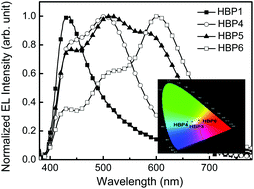Synthesis of conjugated, hyperbranched copolymers for tunable multicolor emissions in light-emitting diodes†
Abstract
A series of conjugated hyperbranched copolymers (HBPs) based on benzothiadiazole derivatives were synthesized via a Suzuki cross-coupling reaction and their white-light emitting properties were explored. Because of their hyperbranched architecture, the phenomenon of intermolecular exciton migration could be effectively controlled to facilitate the tuning of multicolor emission. The feed ratios of monomers containing fluorophores for red, green, and blue emission were carefully manipulated to obtain the expected emission color for a conjugated HBP-based device. While the conjugated HBPs showed very similar fluorescence colors at around 430 nm in their solutions regardless of the variations in their monomer feedings, a variety of emission colors were observed in the solid state in conjunction with their monomer feed ratios. Conjugated HBP-based light-emitting devices were fabricated and almost pure white-light was observed with Commission of International de L'Eclairage coordinates of (0.32, 0.35).


 Please wait while we load your content...
Please wait while we load your content...